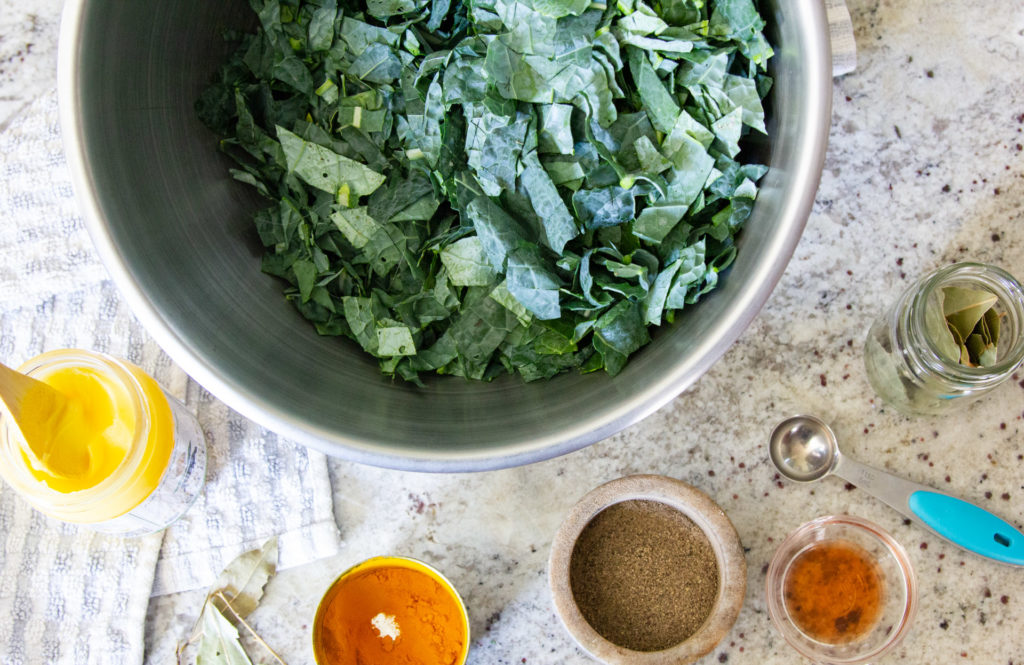Feeling heavy? This simple, yet flavorful, kale soup recipe is highly supportive for cleanse and detox.
If you’re feeling like you’ve overindulged lately, and your digestive tract could use a rest from a lighter meal, eat this soup to feel better right away.

One Day Fast Option
You could turn this soup into a fasting ritual by choosing to eat this simple kale soup for lunch and supper one day a week.
This suggestion come from Ayurvedic practitioner and Joyful Belly School of Ayurvedic Diet and Digestion director John Immel.
Here’s how to do it:
On your fasting day, start with a light breakfast, such as oatmeal, khichdi, barley cereal,or simply fresh fruit.
Then have the cleanse and detox kale soup for lunch, and again for supper. Have a larger portion for lunch and a smaller portion for supper.
Eat calmly and chew well. Try to enjoy each bite of your food. I think you'll love the sweetness and texture of the fresh corn contrasting with the kale.
Variations
I encourage you to try this kale soup as the recipe is written the first time.
If it doesn’t taste good to you, or you feel that you want more variety, consider adding more vegetables, such as broccoli, cauliflower, cabbage, celery, celery root, yams, or any other greens. Garlic could also be added.
Kale Health Benefits
Kale is a mildly bitter green that’s literally loaded with beneficial compounds and medicinal properties.
From an Ayurvedic perspective (which is the modality I practice as a Nutrition and Digestive Health Coach), anything bitter supports digestion.
The bitter taste is both cooling and anti-inflammatory. It also supports peristalsis, which refers to the movement of food through the digestive tract. Kale keeps things movin' - so they say.

All leafy greens have this effect, and this is why a daily serving of leafy greens is recommended if you regularly feel heavy, or your digestion is slow.
The bitter taste also supports bile flow. Bile stores toxins after they are neutralized by the liver, and flushing bile with bitter foods like kale flushes these toxins.
Kale Nutrition
From the Western perspective, we see that kale is antioxidant-rich, and packs whopping levels of vitamins A, K, and C, as well as considerable amounts of vitamin B6, manganese, calcium, copper, potassium, and magnesium.Just one cup of cooked kale contains:
- Vitamin A: 206% of the US recommended daily allowance
- Vitamin K: 684% of the US recommended daily allowance
- Vitamin C: 134% of the US recommended daily allowance
Did you know that one cup of cooked kale has more vitamin C than an orange? Amazing right?
You also get a little omega-3 fat from kale.
And all of this with just 33 calories.
Why Use Ghee?
The preferred fat source for this cleanse kale soup is ghee, which is one of the lightest fats to digest.
Ghee is a very healthy fat that’s made by simmering butter under low heat until it’s highly purified. All the moisture and proteins that make dairy difficult to digest are removed in this process.
According to Ayurveda, ghee is able to assist in the delivery of nutrition into your cells due to its molecular structure.
And I could go on and on about the benefits of ghee. You can read more about it here if you like.
Spices For Kale Soup

I always use spices in my cooking, because the spices assist with the assimilation and absorption of the nutrition from food.
Kale is also incredibly cooling, so the addition of turmeric, black pepper, bay leaf, and red wine vinegar, add warmth and stimulate metabolism so that you can digest the kale.
You won’t find this information about digestion hardly anywhere else - and it’s very important! Those cold, raw kale salads out there are very difficult to digest!
Turmeric invigorates, purifies, and moves the blood. It is one of the very best spices to thin down thick, sweet blood.
Turmeric dries dampness, and its bitter taste is mildly cleansing for the liver and blood. It is known to improve circulation and lymph drainage by thinning the blood.
Black pepper improves circulation by expanding the blood vessels. It also destroys mucus in the digestive tract and sinuses.
Bay leaf is warming, alkalizing, and light. I highly recommend bay leaf when cooking soups and stews involving beans and lentils.
Red wine vinegar heats up digestion, and aids in fat digestion.
Ingredients
For the first step
- 2 teaspoons ghee
- ½ teaspoon turmeric powder
- ½ teaspoon black pepper
- 1 bay leaf
For the second step
- 4 cups water or vegetable stock
- 6 cups kale, washed and chopped
- 1 teaspoon red wine vinegar, (sub with lemon juice)
- ¼ teaspoon Himalayan pink salt
For the third step
- 1 cob corn , kernels only (sub with ½ cup frozen corn)
Optional ingredients
- chat masala, (see notes)
Instructions
-
Heat ghee in a large saucepan on medium heat. Add turmeric, black pepper and bay leaf and sizzle for 20 seconds to release the aroma and the medicinal properties of the spices.
-
Add water, kale, red wine vinegar, and salt, and bring to a boil. Reduce heat and simmer for 15 minutes.
-
Add corn and simmer for 5 minutes. The kale should be soft. If not, continue to cook a little longer. Taste, and adjust for salt.
Notes






